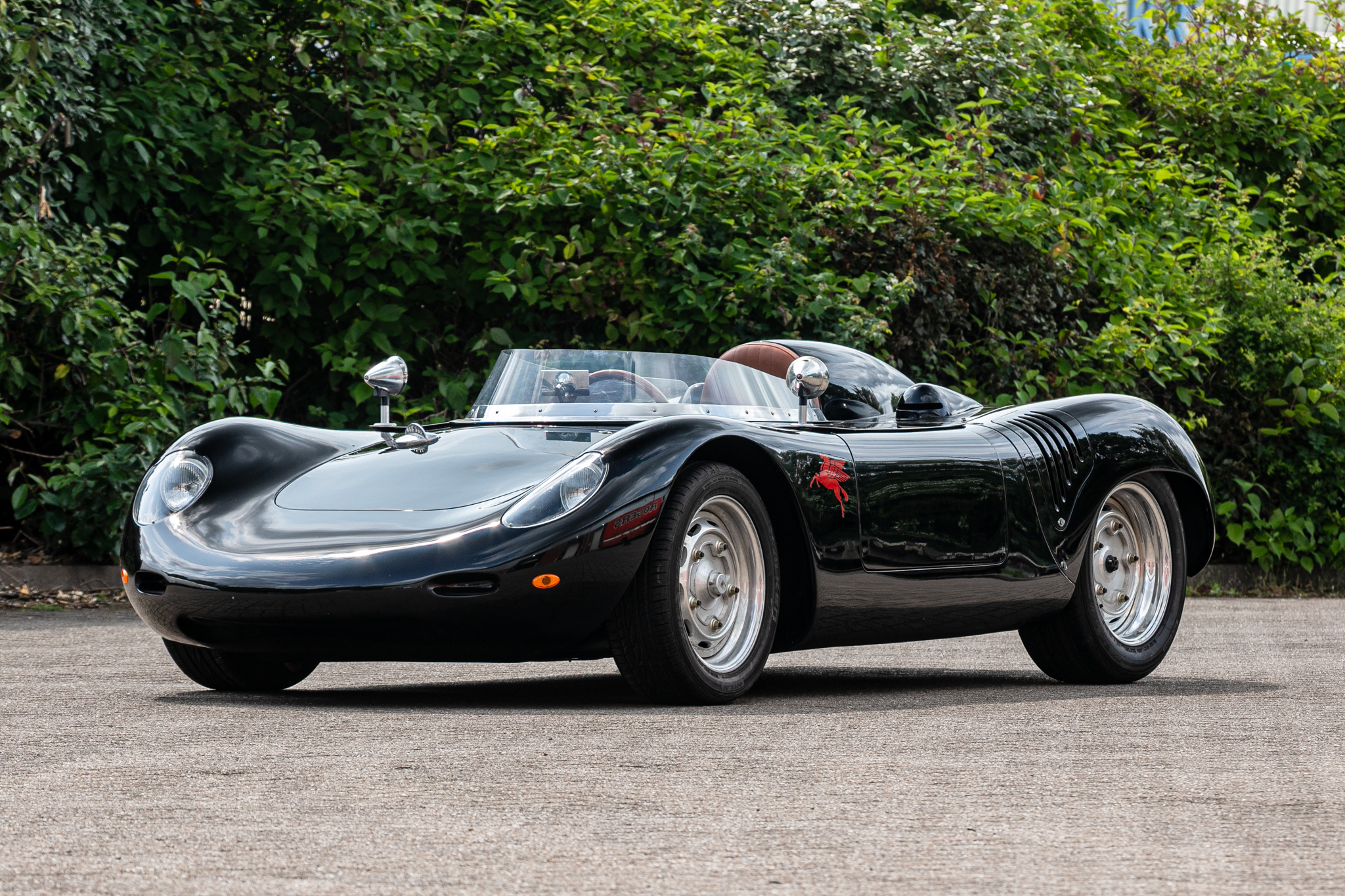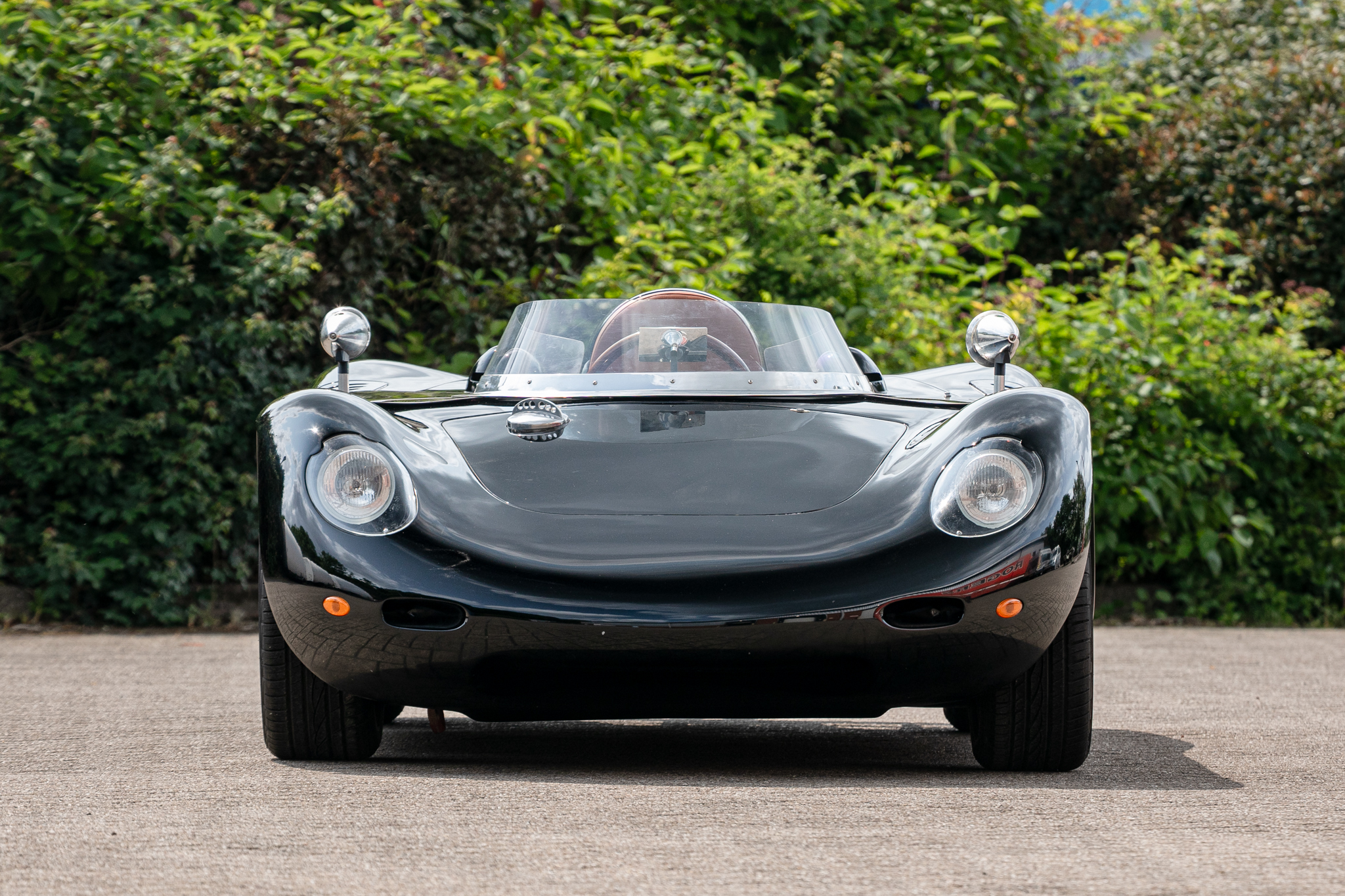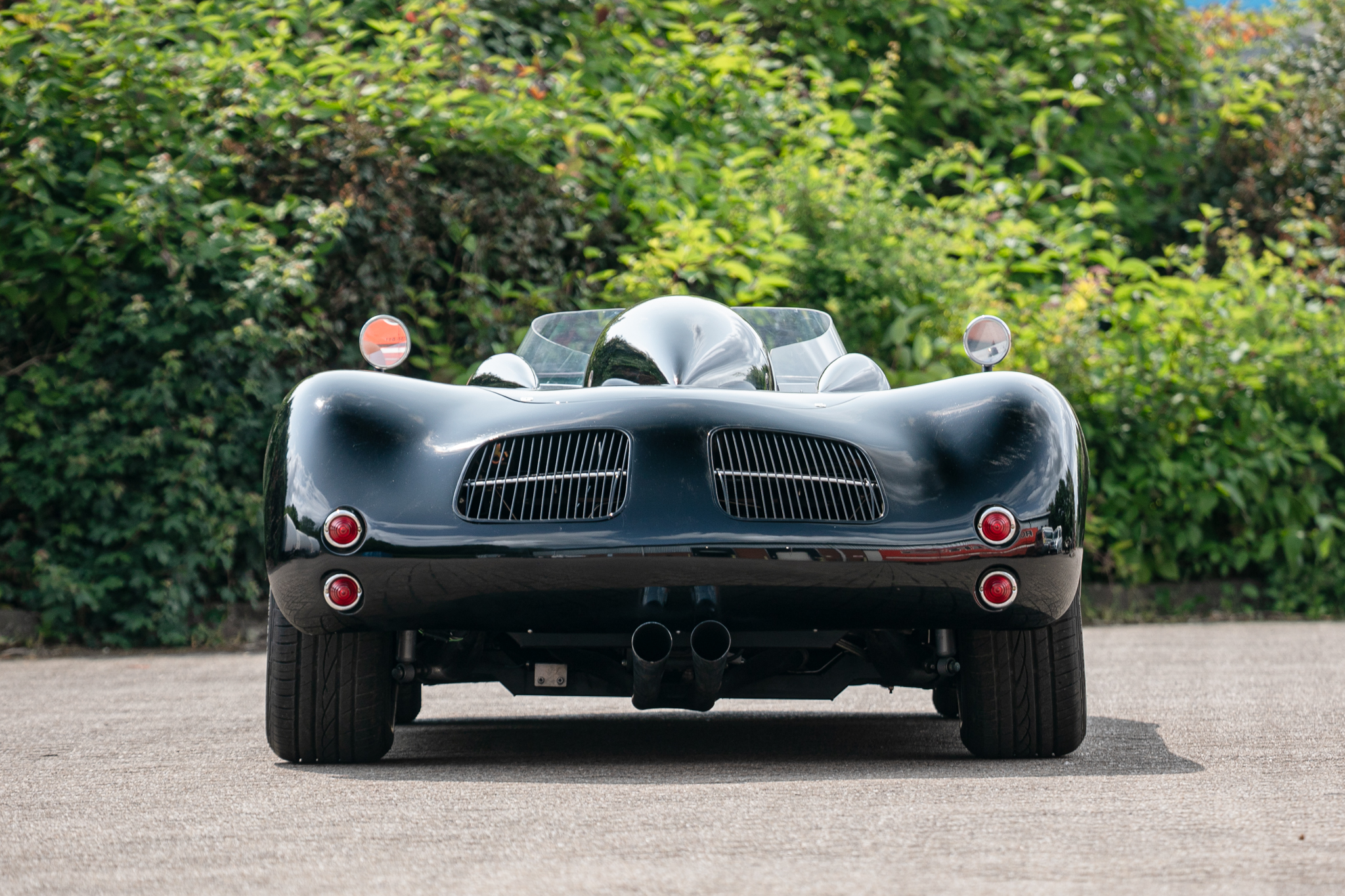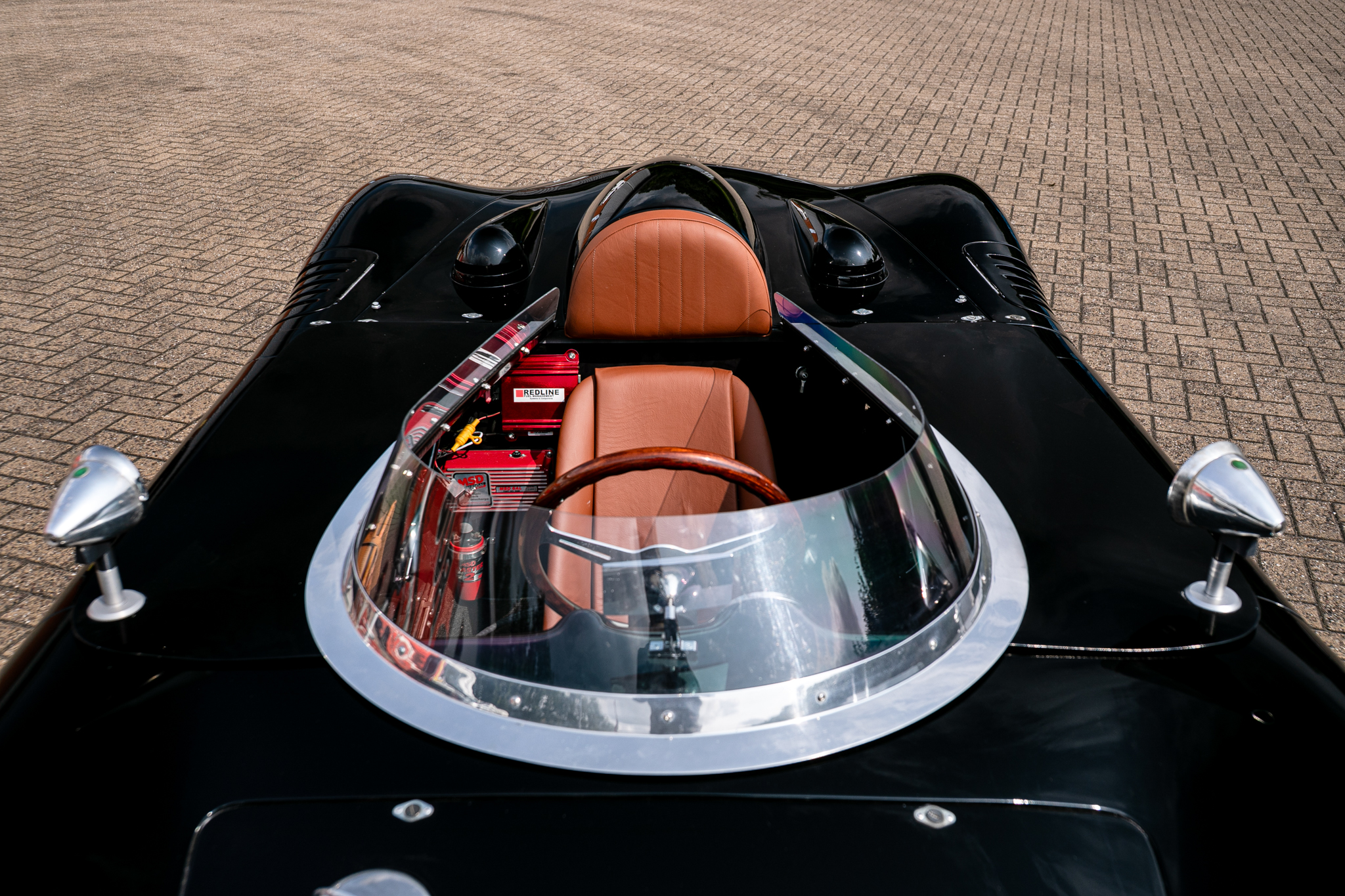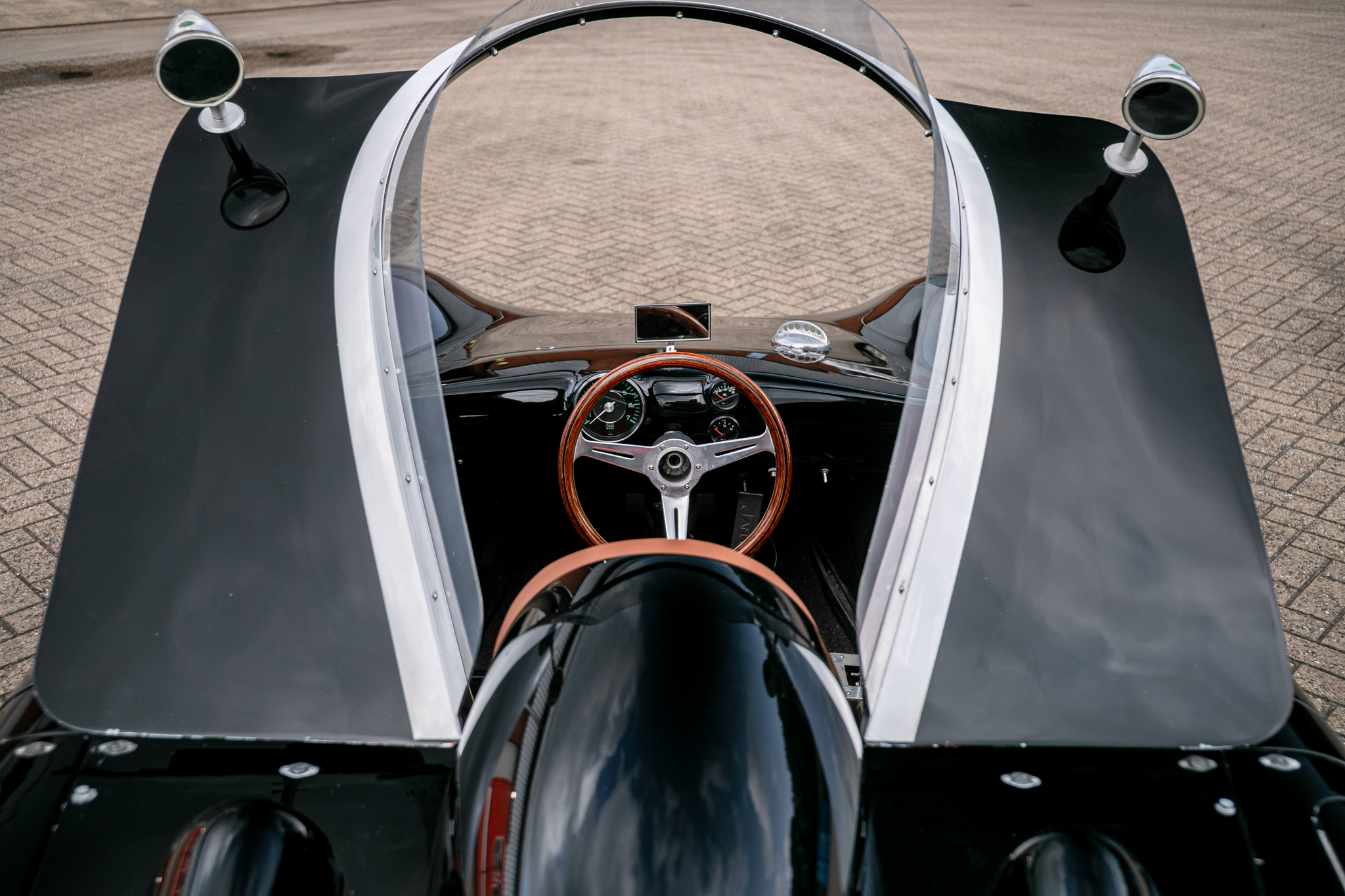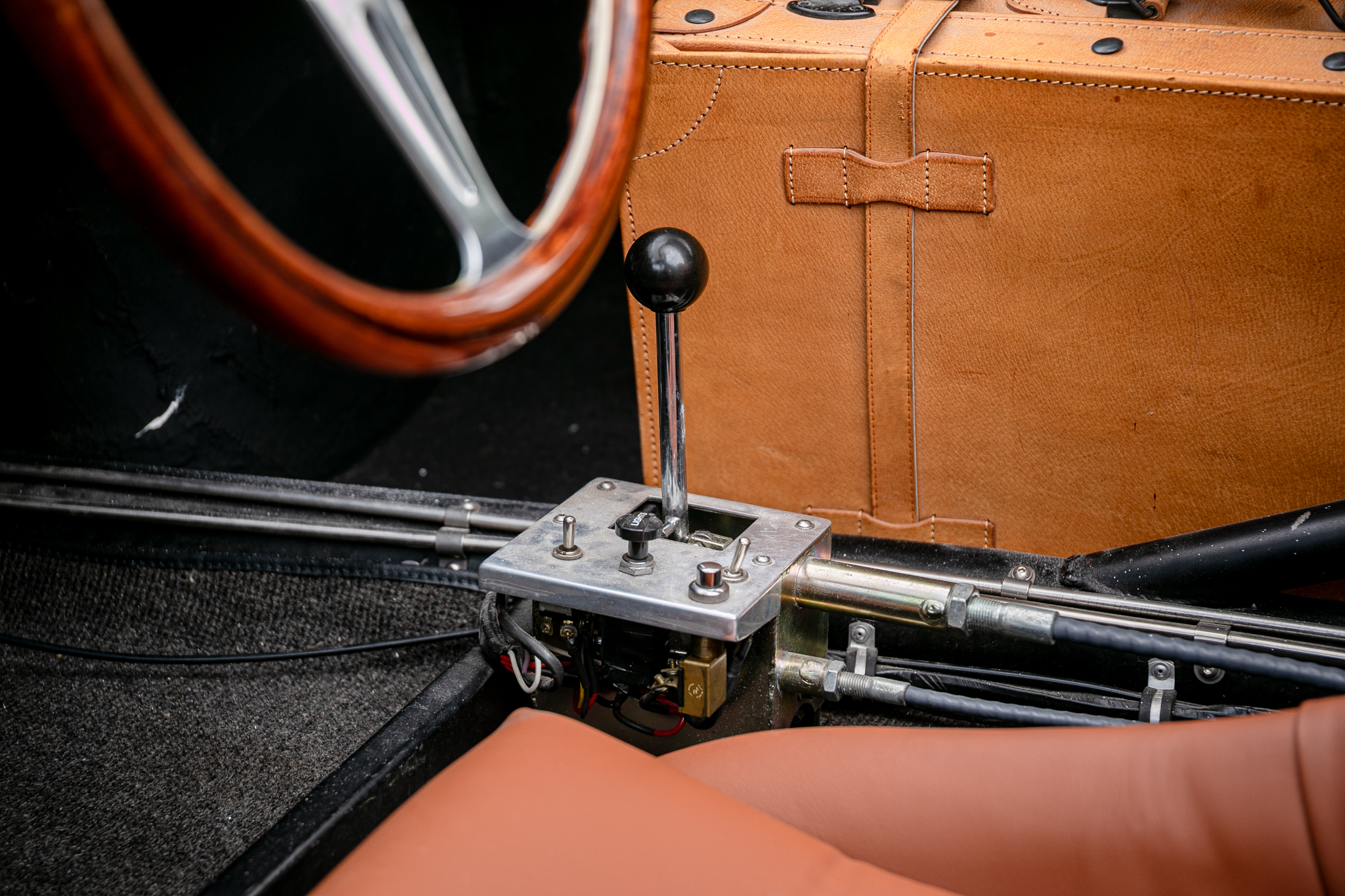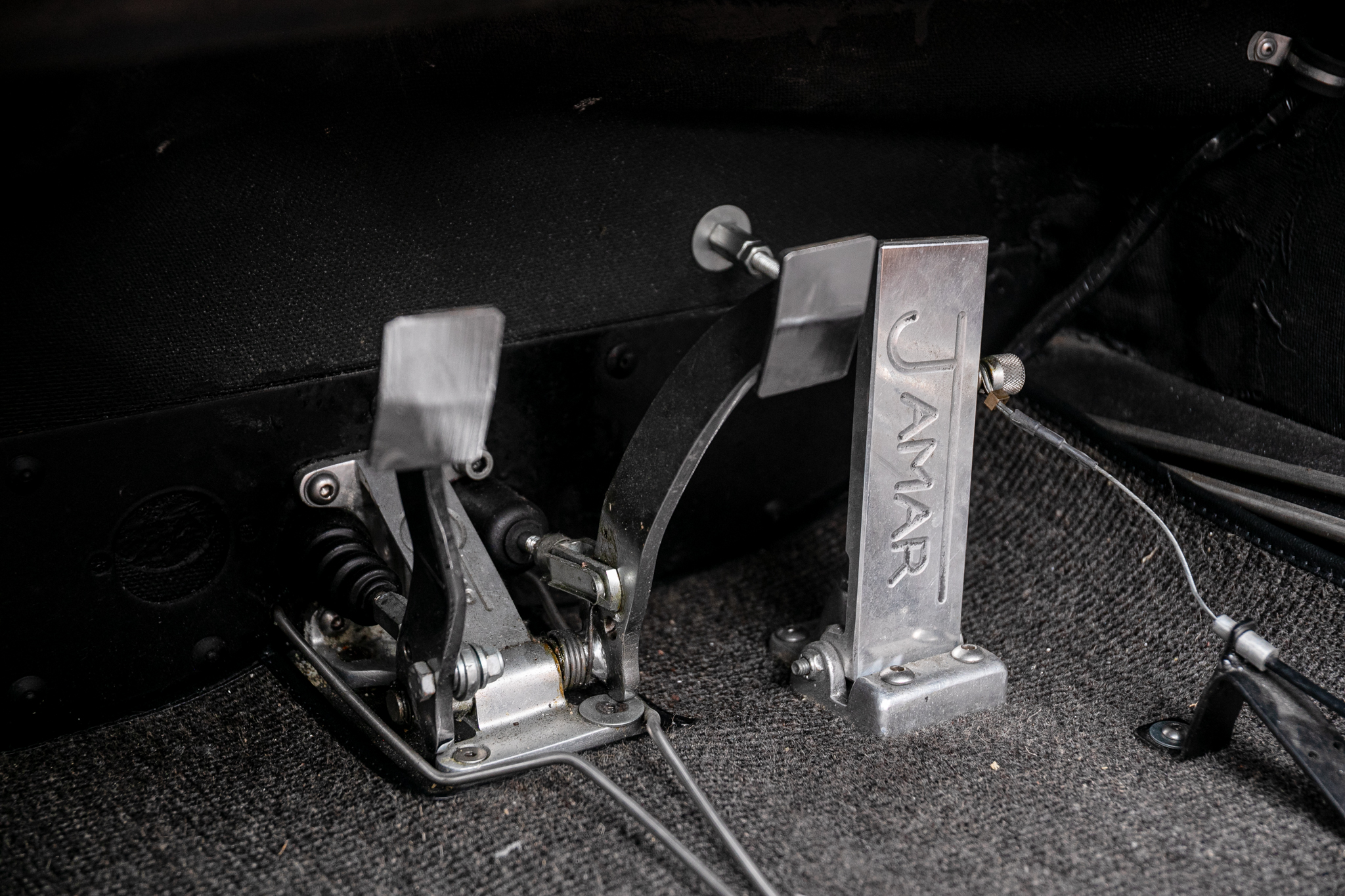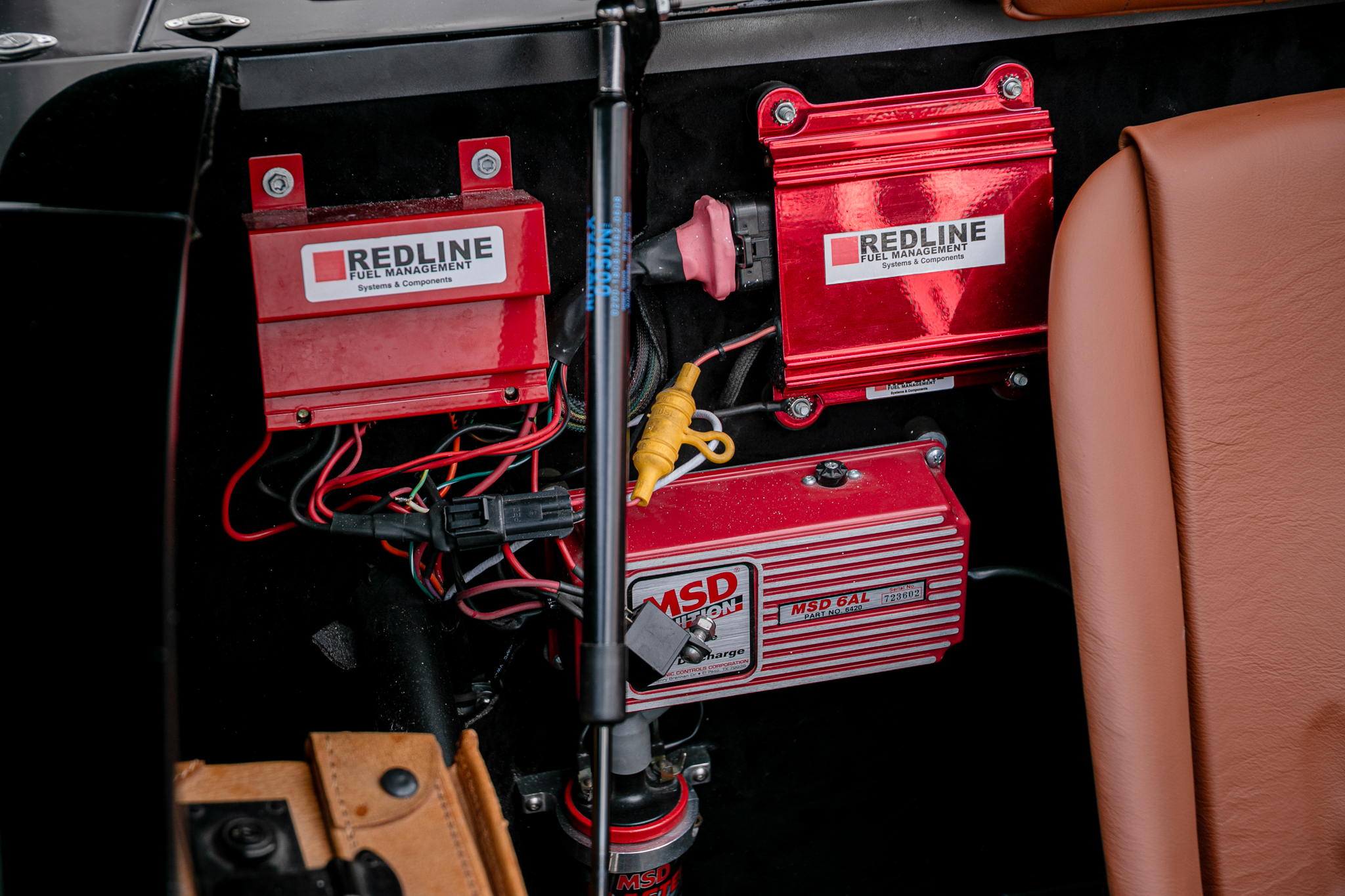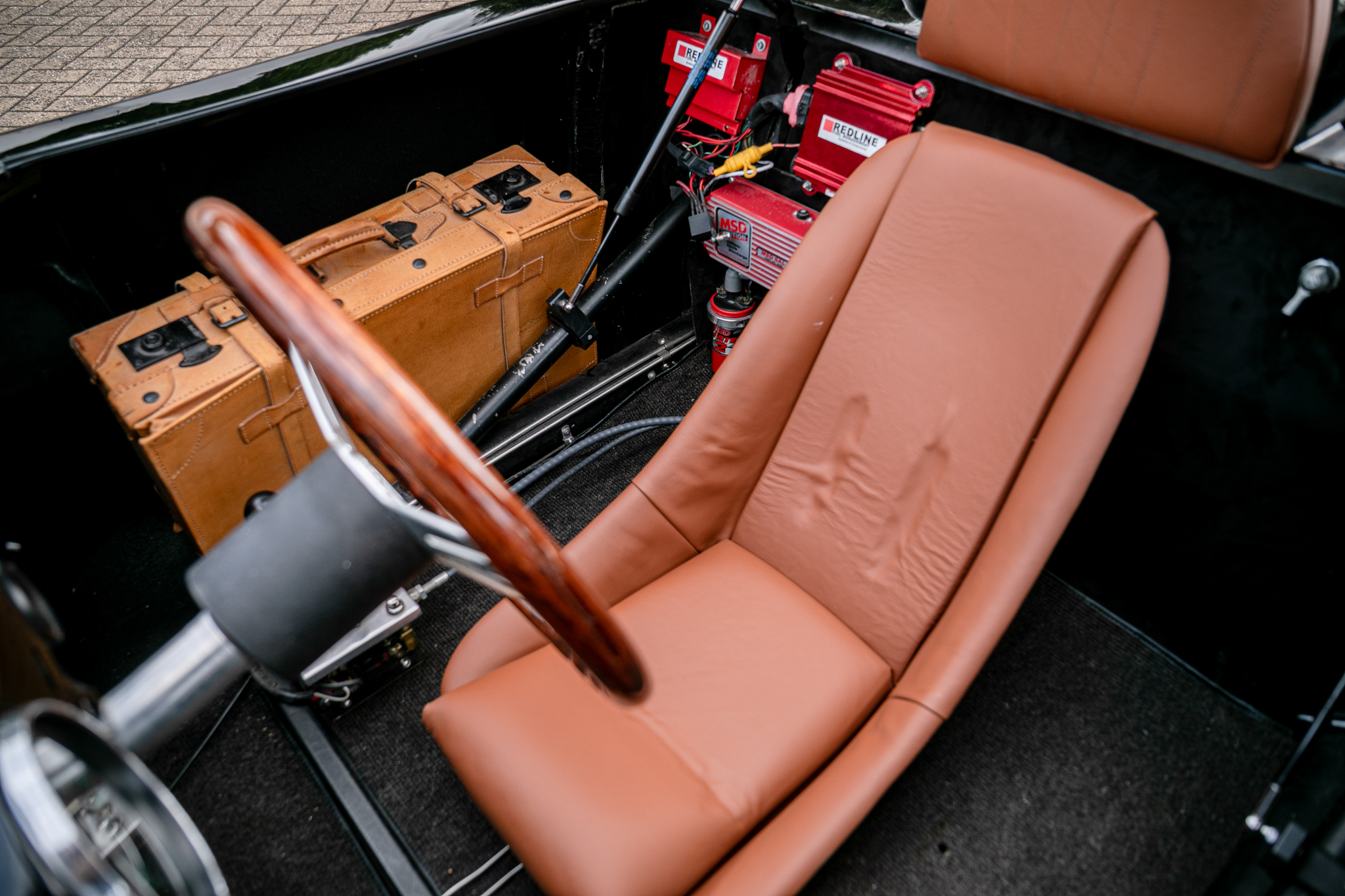Thunder Ranch Porsche 718 RSK Central-seat Spyder Replica
Price: £59,500
Body Colour: Black
Drive: Central-seat
REG Number: N/A
Odometer Reading: N/A
CONTACT
gary@iconicauctioneers.com
Tel: 01926 691 141
Tel: 01926 691 141
DESCRIPTION
By 1953, Porsche had been very successful racing its 356, but recognised it would need a true purpose-built race car to compete at motor sport’s highest levels. The resulting design, the 550 Spyder, became one of the company’s most significant race cars, paving the way for Porsche’s eventual motor sports dominance with specially built, lightweight racing cars.
Following the enormous success of the Type 550 program, Porsche unveiled the next evolution of its lightweight, four-cam Spyder during the 1957 racing season. Internally designated as Type 718, the RSK replaced the 550A, a car that had dominated its class and furthered Porsche’s reputation as a manufacturer of innovative competition cars.
Visually, the RSK was more modern than its predecessor, with streamlined Wendler coachwork and faired-in headlamps, resulting in lower aerodynamic drag. Beneath the thin alloy skin, the RSK benefited from thorough development and offered more power, better braking, and improved suspension.
The Ernst Fuhrmann-designed four-cam engine was an advanced version of the Type 547 unit and it gained power and durability through adjustments to the roller-bearing crankshaft, cam timing, and compression. Delivering its power through a magnesium-cased, five-speed transaxle, the RSK was easily adapted to a variety of applications, from hill-climbs to high-speed circuit races.
In 1958, the 718 RSK took the racing world by storm, winning its class and finishing on the podium at Sebring, Le Mans, and the Targa Florio with, perhaps, its most notable result being the following year’s Targo Florio where a works-entered car took the overall win, leading Porsche’s 1-2-3 finish at the legendary Italian event.
With the RSK, Porsche had a true giant-killer. Although Porsche built just 34 examples, this important model set the tone for decades of dominance at the height of international sports car racing.
The 718RSK was never available as a road car and the majority of the factory-built racers have long since been scrapped or written off with just 10 understood to remain in private collections. The combination of the car’s popularity, scarcity, substantial price tag if you could find one, and the fact that it was a simple design, made the 718 RSK a prime candidate for the replica or “evocation” market.
One such builder was Tom McBurnie, the owner of Thunder Ranch in El Cajon, California. As a multiple-award-winning automotive designer, Tom has been creating cool cars since 1978 and Thunder Ranch have built up an International reputation for creating awesome replicas of the Porsche 356 Speedster, the 550 Spyder, and the 718 RSK. On this side of the pond, they are probably best known for the replica Daytona Spyders with glass fibre bodies fitted on to Corvette C3 chassis for the TV show Miami Vice for the first two seasons. Before founding his replicar business, Tom raced and won a great many SCCA events in Porsche Speedsters and Spyders in the '60s so he knows these little cars well.
Thunder Ranch decided to replicate the RSK Spyder with modifications to the original race car styling that allows the replica to be used on the road. First designed by Chuck Beck, Thunder Ranch uses the single-crossmember 550 frame, moved forward slightly to allow the panel from dash to floor to cover it as it does in the 550. After the frame is fabricated, it's powder-coated prior to Thunder Ranch’s hand-laid DPCD blended polyester body being bonded to the frame with adhesive and rivets. The bonnet, engine cover, and doors are then hand-fitted with new or handmade hardware.
This particular RSK Spyder was built to showcase McBurnie's Thunder Ranch range at the 2005 Speciality Equipment Market Association's (SEMA) annual event in Las Vegas and was rather special. To enable the car to be US road-registered, it was regarded officially as a re-bodied Porsche 914 from 1972 and the early details on the title relate to its last owner.
Classically finished in Porsche Silver with orange accents, it was configured with a central seating position (centre steer). According to Tom, there were only four ‘centre steers’ ever built but three of them were designed to enable a swap to left-hand drive, depending on the race regulations, meaning this example is unique and, although he is still actively building cars well into his eighties, Tom swears that there will never be a second. It was powered by a SCAT-built, fuel-injected, 2.8-litre, VW flat-four (Type 1), with an extra large oil sump and rear located oil cooler, mated to a VW gearbox with high gearing enabling the aerodynamic little roadster to cruise at high speeds.
Thomas kept the car as a demonstrator and for personal use until 2010 before refinishing the car in black and selling it to the renowned Austrian artist in glass, Joseph S Salvenmoser. The RSK then became part of the Salvenmoser Collection of important Porsches which at one point numbered over 30 classic Porsches. It subsequently spent several years with a well known Porsche specialist in Zell-am-See in Austria before being purchased by our vendor.
In recent correspondence he mentions “The car has a flip windscreen cowling which is electronically latched or unlatched similar to that of a bonnet. There is one working door (left side) and the other side is only optically a door and is, in fact, part of the main body. The wheels are machined from a solid disc of alloy and the car has no handbrake or park brake. The car is currently black and, although it looks fantastic with the colour change, I would recommend it be put back to its original Silver. The body panels are free from damage but may need the twist clips renewing (not necessary just detailing). If remaining in the UK, then a set of headlights with a different dip direction will be needed.”
Prior to loaning the car to the ‘Klassiker Black and White’ show in Friedrichshafen, where it was treated like a star, he retrimmed the interior in the Saddle Tan leather you see today as he felt that, not only would it look great against the gleaming black coachwork, it would also fit perfectly with silver and orange should it be put back to original.
Our vendor now feels that, having had many years of pleasure showing the car off at local Oldtimer meetings and making many new friends, the time is right to say goodbye.
Following the enormous success of the Type 550 program, Porsche unveiled the next evolution of its lightweight, four-cam Spyder during the 1957 racing season. Internally designated as Type 718, the RSK replaced the 550A, a car that had dominated its class and furthered Porsche’s reputation as a manufacturer of innovative competition cars.
Visually, the RSK was more modern than its predecessor, with streamlined Wendler coachwork and faired-in headlamps, resulting in lower aerodynamic drag. Beneath the thin alloy skin, the RSK benefited from thorough development and offered more power, better braking, and improved suspension.
The Ernst Fuhrmann-designed four-cam engine was an advanced version of the Type 547 unit and it gained power and durability through adjustments to the roller-bearing crankshaft, cam timing, and compression. Delivering its power through a magnesium-cased, five-speed transaxle, the RSK was easily adapted to a variety of applications, from hill-climbs to high-speed circuit races.
In 1958, the 718 RSK took the racing world by storm, winning its class and finishing on the podium at Sebring, Le Mans, and the Targa Florio with, perhaps, its most notable result being the following year’s Targo Florio where a works-entered car took the overall win, leading Porsche’s 1-2-3 finish at the legendary Italian event.
With the RSK, Porsche had a true giant-killer. Although Porsche built just 34 examples, this important model set the tone for decades of dominance at the height of international sports car racing.
The 718RSK was never available as a road car and the majority of the factory-built racers have long since been scrapped or written off with just 10 understood to remain in private collections. The combination of the car’s popularity, scarcity, substantial price tag if you could find one, and the fact that it was a simple design, made the 718 RSK a prime candidate for the replica or “evocation” market.
One such builder was Tom McBurnie, the owner of Thunder Ranch in El Cajon, California. As a multiple-award-winning automotive designer, Tom has been creating cool cars since 1978 and Thunder Ranch have built up an International reputation for creating awesome replicas of the Porsche 356 Speedster, the 550 Spyder, and the 718 RSK. On this side of the pond, they are probably best known for the replica Daytona Spyders with glass fibre bodies fitted on to Corvette C3 chassis for the TV show Miami Vice for the first two seasons. Before founding his replicar business, Tom raced and won a great many SCCA events in Porsche Speedsters and Spyders in the '60s so he knows these little cars well.
Thunder Ranch decided to replicate the RSK Spyder with modifications to the original race car styling that allows the replica to be used on the road. First designed by Chuck Beck, Thunder Ranch uses the single-crossmember 550 frame, moved forward slightly to allow the panel from dash to floor to cover it as it does in the 550. After the frame is fabricated, it's powder-coated prior to Thunder Ranch’s hand-laid DPCD blended polyester body being bonded to the frame with adhesive and rivets. The bonnet, engine cover, and doors are then hand-fitted with new or handmade hardware.
This particular RSK Spyder was built to showcase McBurnie's Thunder Ranch range at the 2005 Speciality Equipment Market Association's (SEMA) annual event in Las Vegas and was rather special. To enable the car to be US road-registered, it was regarded officially as a re-bodied Porsche 914 from 1972 and the early details on the title relate to its last owner.
Classically finished in Porsche Silver with orange accents, it was configured with a central seating position (centre steer). According to Tom, there were only four ‘centre steers’ ever built but three of them were designed to enable a swap to left-hand drive, depending on the race regulations, meaning this example is unique and, although he is still actively building cars well into his eighties, Tom swears that there will never be a second. It was powered by a SCAT-built, fuel-injected, 2.8-litre, VW flat-four (Type 1), with an extra large oil sump and rear located oil cooler, mated to a VW gearbox with high gearing enabling the aerodynamic little roadster to cruise at high speeds.
Thomas kept the car as a demonstrator and for personal use until 2010 before refinishing the car in black and selling it to the renowned Austrian artist in glass, Joseph S Salvenmoser. The RSK then became part of the Salvenmoser Collection of important Porsches which at one point numbered over 30 classic Porsches. It subsequently spent several years with a well known Porsche specialist in Zell-am-See in Austria before being purchased by our vendor.
In recent correspondence he mentions “The car has a flip windscreen cowling which is electronically latched or unlatched similar to that of a bonnet. There is one working door (left side) and the other side is only optically a door and is, in fact, part of the main body. The wheels are machined from a solid disc of alloy and the car has no handbrake or park brake. The car is currently black and, although it looks fantastic with the colour change, I would recommend it be put back to its original Silver. The body panels are free from damage but may need the twist clips renewing (not necessary just detailing). If remaining in the UK, then a set of headlights with a different dip direction will be needed.”
Prior to loaning the car to the ‘Klassiker Black and White’ show in Friedrichshafen, where it was treated like a star, he retrimmed the interior in the Saddle Tan leather you see today as he felt that, not only would it look great against the gleaming black coachwork, it would also fit perfectly with silver and orange should it be put back to original.
Our vendor now feels that, having had many years of pleasure showing the car off at local Oldtimer meetings and making many new friends, the time is right to say goodbye.

